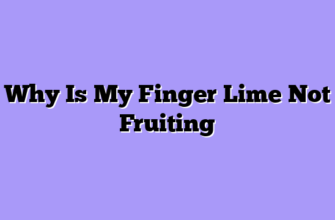Known locally as “citrus caviar” or “lime caviar” for its remarkable pearl-like vesicles that pop with tangy flavor, this fruit has transformed from an obscure botanical curiosity into one of my farm’s signature crops—and a chef’s darling across the country.
My Journey with Australian Finger Limes
I still remember the day I received my first finger lime cuttings in 2010. They arrived in a simple cardboard box, looking like nothing more than a few twigs with leaves. Little did I know these unassuming specimens would eventually become the cornerstone of my exotic fruit operation.

“These aren’t your grandpa’s lemons,” I often joke to visitors touring my orchard. And they certainly aren’t. Unlike conventional citrus, finger limes evolved in the understory of Australia’s eastern coastal rainforests, giving them unique growing requirements that took me years to fully understand.
Understanding the Citrus Caviar’s Growth Patterns
Finger limes are woodland understory plants in their native habitat—an important fact that many first-time growers overlook. In my experience, they prefer dappled light rather than full, harsh sun. When I first planted them in an exposed section of my farm, the leaves scorched, and fruit production was minimal. After moving them to a partially shaded area with morning sun and afternoon protection, they flourished.
The bushes themselves are something to behold. Unlike traditional citrus trees with their predictable growth patterns, finger limes grow more like shrubs—often reaching 6-10 feet tall with a distinctive, somewhat wild appearance. Their thorny branches create a defensive barrier that would make any medieval castle proud. I’ve lost count of how many shirts I’ve sacrificed to these impressive thorns while harvesting.
“They’re the punk rockers of the citrus world,” I tell my farm interns. “Spiky, rebellious, and absolutely unforgettable once you get to know them.”
Propagation Methods That Actually Work
In my years of growing these remarkable fruits, I’ve tried every propagation method in the book. Let me share what actually works based on my hands-on experience:
Cutting Propagation: My Go-To Method
Taking cuttings remains my preferred method for expanding my finger lime plantation, offering the most reliable results for my climate and conditions. Here’s my time-tested approach:
- Timing is everything: I take semi-hardwood cuttings in late spring when the plant is actively growing but the stems have partially matured. In Southern California, this typically falls in May.
- Selection matters: I select branch segments about 6-8 inches long with healthy foliage, avoiding flowering branches (they’re less likely to root successfully).
- Preparation is key: After removing lower leaves and treating the cut end with rooting hormone (I prefer the powder form with 0.8% IBA), I plant them in a well-draining mix of 50% perlite and 50% peat moss.
- Environment control: Maintaining high humidity without waterlogging is crucial. I use a simple DIY propagation box with bottom heat (72-75°F) and indirect light.
My success rate with this method hovers around 70-75%—significantly higher than my early attempts which barely reached 30%.
Grafting: For Advanced Growers
While cuttings work well, I’ve achieved even faster production through grafting onto suitable rootstocks. After experimenting with various options, I’ve found that ‘Flying Dragon’ trifoliate orange rootstock produces the most compact, productive trees for my operation.
The grafting process requires precision and practice. I use a whip and tongue graft in late winter when both the rootstock and scion are dormant. The union typically heals within 3-4 weeks under controlled conditions.
Air-Layering: My Backup Approach
When dealing with particularly valuable varieties, I sometimes use air-layering as a propagation method. This involves creating a wound on a branch, surrounding it with moist sphagnum moss wrapped in plastic, and waiting for roots to form before separating the new plant.
Though more labor-intensive, this approach offers near 100% genetic continuity and higher success rates for difficult-to-root varieties like some of the rarer red-fleshed types.
Variety Selection: Beyond the Basics
Through years of trial and error (emphasis on the error), I’ve grown over a dozen different finger lime varieties. Each has its unique characteristics that influence not just flavor but growth habits and market potential.
| Variety | Pulp Color | Flavor Profile | Growth Habit | Special Notes |
|---|---|---|---|---|
| Australian Green | Pale green | Bright, lime-forward | Upright, 8-10 ft | My most reliable producer |
| Pink Crystal | Pink to red | Sweet-tart, berry hints | Bushy, 6-8 ft | Commands premium prices |
| Crimson Tide | Deep red | Complex, slightly sweeter | Spreading, 5-7 ft | Slower growing but worth the wait |
| Alstonville | Greenish-gold | Lemon-lime, aromatic | Columnar, 8-12 ft | Most cold-tolerant in my collection |
| Durham’s Emerald | Bright green | Intense, concentrated | Compact, 4-6 ft | Perfect for container growing |
The Pink Crystal variety has become my farm’s signature offering, with local chefs often pre-ordering the entire harvest before the season even begins.
Cultivation Challenges: Lessons from My Failures
I’d be doing you a disservice if I painted finger lime cultivation as nothing but success. The truth is, I’ve killed more finger lime plants than I care to admit. Here are the hard-won lessons from my failures:
Water Management: A Delicate Balance
Finger limes have specific watering needs that differ from conventional citrus. They’re surprisingly drought-tolerant once established but absolutely despise waterlogged soil. My first plantation suffered from root rot because I treated them like traditional lemons.
I now use a drip irrigation system that delivers precise amounts of water directly to the root zone. During summer, mature plants receive deep watering once weekly rather than frequent light watering. In winter, I cut back significantly, sometimes watering only once every 3-4 weeks depending on rainfall.
Soil Requirements: Not What You’d Expect
These Australian natives evolved in relatively poor soil conditions and actually perform worse in overly rich soils. My first planting bed was amended with excessive organic matter and fertilizer, resulting in lush foliage but minimal fruit.
My current approach focuses on excellent drainage above all else. I plant in raised beds with a mix of native soil, coarse sand, and minimal compost. The pH is maintained between 5.5-6.5—slightly more acidic than what’s recommended for conventional citrus.
Pest Management: The Unexpected Visitors
While finger limes have fewer pest issues than many exotic fruits I grow, they do attract some unwelcome visitors. Scale insects have been my primary nemesis, hiding along the thorny branches where they’re difficult to detect until an infestation is well established.
I’ve found that maintaining a healthy population of beneficial insects through companion planting has been more effective than reactive treatments. Lacewings and ladybugs have become valuable allies in keeping scale insects in check.
Harvesting and Marketing: From Farm to Table
The moment of harvest brings both excitement and challenges. Finger limes don’t change color dramatically when ripe, making harvesting decisions somewhat subjective. I’ve developed a touch-based approach—the fruits have a slight give when gently squeezed at peak ripeness.
Unlike conventional citrus with their predictable harvesting windows, finger limes on the same plant often ripen over several weeks. This extended harvest period is actually a marketing advantage, allowing me to supply restaurants with fresh product over a longer season.
Speaking of marketing, I’ve found that education is essential when selling finger limes. Many customers are initially confused by these cylindrical fruits that bear little resemblance to conventional limes. In-store demonstrations showing the caviar-like pearls bursting from the fruit have proven invaluable for direct sales.
The Economics of Exotic Citrus
Let’s talk numbers. Finger limes aren’t just fascinating botanically—they make good business sense for the right operation. My mature plants produce approximately 2-3 pounds of fruit annually, which might not sound impressive until you consider the price point.
While conventional limes might sell for $1-2 per pound wholesale, my finger limes command $25-30 per pound to restaurants and specialty markets. Even with higher production costs and more intensive labor requirements, the profit margins are substantially better than most citrus crops.
The initial investment is significant—quality finger lime plants can cost $30-50 each, compared to $10-15 for conventional citrus. However, the breakeven point typically comes in the third or fourth year, followed by decades of productive harvests.
Looking to the Future
As I look toward the future of my finger lime operation, I’m experimenting with new production methods that might increase yields while maintaining quality. High-density plantings using advanced pruning techniques show promise, potentially doubling production in the same space.
Climate change presents both challenges and opportunities. While increasing temperatures could extend the growing range northward, changing precipitation patterns and more frequent weather extremes create new management challenges.
I’m particularly excited about emerging research on finger lime compounds that show promising antimicrobial properties. Beyond culinary applications, these unique fruits may eventually find their way into natural preservatives or health supplements.
Final Thoughts
Farming finger limes has taught me patience, humility, and the rewards of specialization. These aren’t crops for the impatient farmer looking for quick returns, but for those willing to invest the time to understand their unique requirements, they offer both financial rewards and the satisfaction of bringing something truly special to market.
As I walk through my finger lime orchard in the golden California sunset, thorny branches catching the light, I’m reminded of why I chose this path. In a world of standardized, industrialized agriculture, there’s profound satisfaction in nurturing these botanical treasures and sharing them with appreciative chefs and consumers who value something extraordinary.
If you’re considering adding finger limes to your operation, prepare for challenges, expect setbacks, but know that the journey is worthwhile. These remarkable fruits have transformed my farm and might just do the same for yours.








